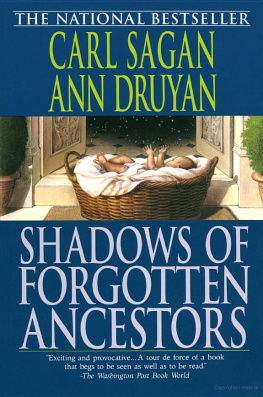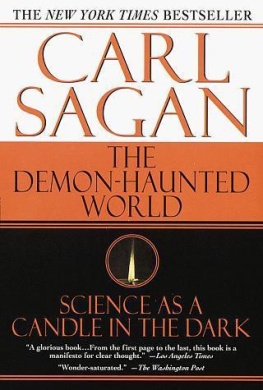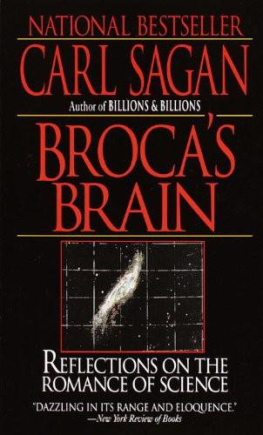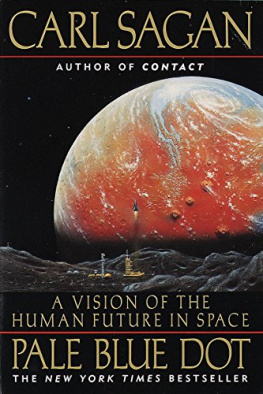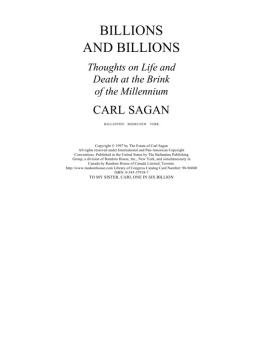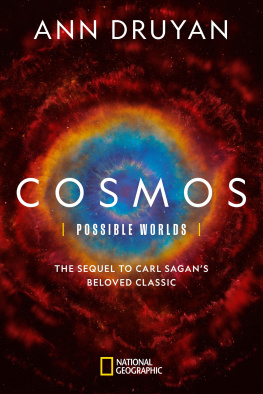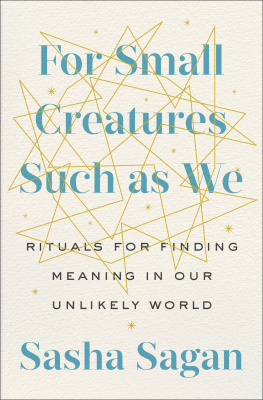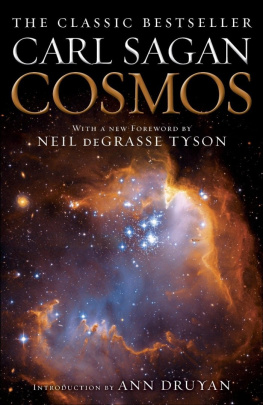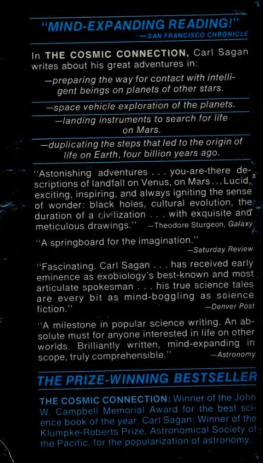Shadows of Forgotten Ancestorswas selected bySchool Library Journalas one of nine best books of the year out of 40,000 titles: The enchanting writing style captivates a clarity that will hold the interest of the most science-phobic reader.
A funhouse maze of biology, psychology, evolution, fact, theory, probability, possibility, and awe Warning Those who regard the human condition as the inviolable perch at the top of the evolutionary heap, the gold watch at the end of the great chain of being, will find much in Shadows that disturbs.
Miami Herald
In this book Carl Sagan and Ann Druyan illuminate some of the most daunting questions of our time, and any time, sometimes explaining them straight out, sometimes challenging the reader to contemplate the truths we hold dear. Shadows is one of those rare books that should be required reading.
New Orleans Times-Picayune
Jam-packed with fascinating anecdotes, a playful wit and humor, a wide-ranging command of relevant scientific data, and (a warning to readers who are easily scandalized), an indecorous explicitness on matters sexual.
Nashville Banner
Superb.
Tom Peters
Chicago Tribune
Their latest literary wonder.
New York Times Syndicate
It has been a long time since I came across a nonfiction book as compelling as this one. At times I found myself impatiently turning pages, as if I were reading a murder mystery and couldnt wait to discover the ending.
Corpus Christi Caller-Times
An eloquent attempt to place the human species in context They use the same compelling style that made Cosmos such an international success. It is a big story. Indeed, it is the biggest story.
Worcester (Massachusetts) Telegram
A coherent, moving story Philosophical, poetic, even witty, [with] a sense of almost religious awe.
Book Page
Excellent An important book that deserves to be widely read and discussed.
Monroe Strickberger
Author of the textbook Evolution,
writing in the San Francisco Examiner-Chronicle
Formidably intelligent and well-informed.
Chicago Sun Times
Hauntingly appealing. Carl Sagan is probably the best literary stylist American science has produced since Loren Eiseley and Lewis Thomas.
The Observer (London)
Informative, enlightening, and refreshingly unacademic.
Atlanta Journal & Constitution
It is easy to hear his familiar voice guiding the reader through time and the early rumblings of the universe through the development of DNA, evolution, and the rise of modern primates.
Gannett News Service
Sagans contribution to increasing public understanding of science and making provocative connections between different areas are at the highest level of benefit to our society.
John Bahcall
Institute for Advanced Study Princeton, NJ
It has sex. It has humor. It has drama. Its what people go to the movies for.
Steve Knight
KIEV-AM, Los Angeles
They go boldly where many scientists have feared to tread And what a journey it is!
Phoenix (Arizona) Gazette
Eloquent Visionary Powerfully imagined.
Booklist
Engaging Lyrical Stunning.
Publishers Weekly
ALSO BY CARL SAGAN AND ANN DRUYAN
Comet
Murmurs of Earth (with others)
SOME OTHER BOOKS BY CARL SAGAN
Intelligent Life in the Universe (with I. S. Shklovskii)
The Cosmic Connection
The Dragons of Eden
Brocas Brain
Cosmos
Contact
A Path Where No Man Thought (with Richard Turco)
ALSO BY ANN DRUYAN
A Famous Broken Heart

A carving from the Sepik River, central highlands of Papua New Guinea.
A Ballantine Book
Published by The Random House Publishing Group
Copyright 1992 by Carl Sagan and Ann Druyan
All rights reserved under International and Pan-American Copyright Conventions Published in the United States by Ballantine Books, an imprint of The Random House Publishing Group, a division of Random House, Inc, New York, and simultaneously in Canada by Random House of Canada Limited, Toronto
This edition published by arrangement with Random House, Inc
Permissions acknowledgments for previously published
material can be found on
Library of Congress Catalog Card Number: 93-90012
Ballantine and colophon are registered trademarks of Random House, Inc
www.ballantinebooks.com
eISBN: 978-0-307-80103-6
v3.1
TO
LESTER GRINSPOON,
WHOSE EXAMPLE REASSURES US
THAT OUR SPECIES
MAY HAVE
WHAT IT TAKES
Thus she spoke; and I longed
to embrace my dead mothers ghost.
Thrice I tried to clasp her
image, and thrice it slipped
through my hands, like a
shadow, like a dream.
HOMER
The Odyssey
Contents
Introduction
We were very lucky. We were raised by parents who took seriously their responsibility to be strong links in the chain of generations. The search that informs this book may be said to have begun in childhood, when we were given unconditional love and protection in the face of real adversity. Its an ancient practice of the mammals. It was never easy. In modern human society, its even harder. There are so many dangers now, so many of them unprecedented.
The book itself began in the early 1980s when the rivalry between the United States and the Soviet Union was making a potentially fateful intersection with 60,000 nuclear weapons that had been accumulated for reasons of deterrence, coercion, pride, and fear. Each nation praised itself and vilified its adversaries, who were sometimes portrayed as less than human. The United States spent ten trillion dollars on the Cold Warenough to buy everything in the country except the land. Meanwhile, the infrastructure was collapsing, the environment was deteriorating, the democratic process was being subverted, injustice festered, and the nation was converted from the leading lender to the leading debtor on the planet. How did we get into this mess? we asked ourselves. How can we get out? Can we get out?
So we embarked on a study of the political and emotional roots of the nuclear arms racewhich led us back to World War II, which of course had its origins in World War I, which was a consequence of the rise of the nation-state, which traces straight back to the very beginnings of civilization, which was a by-product of the invention of agriculture and the domestication of animals, which crystallized out of a very long period in which we humans were hunters and foragers. There was no sharp division along the way, no point at which we could say: Here are the roots of our predicament. Before we knew it, we were looking to the first humans and

